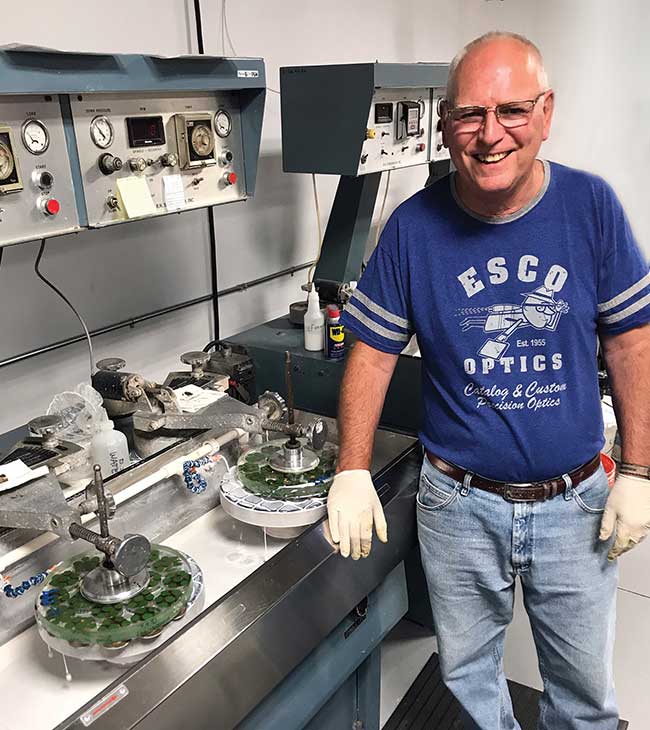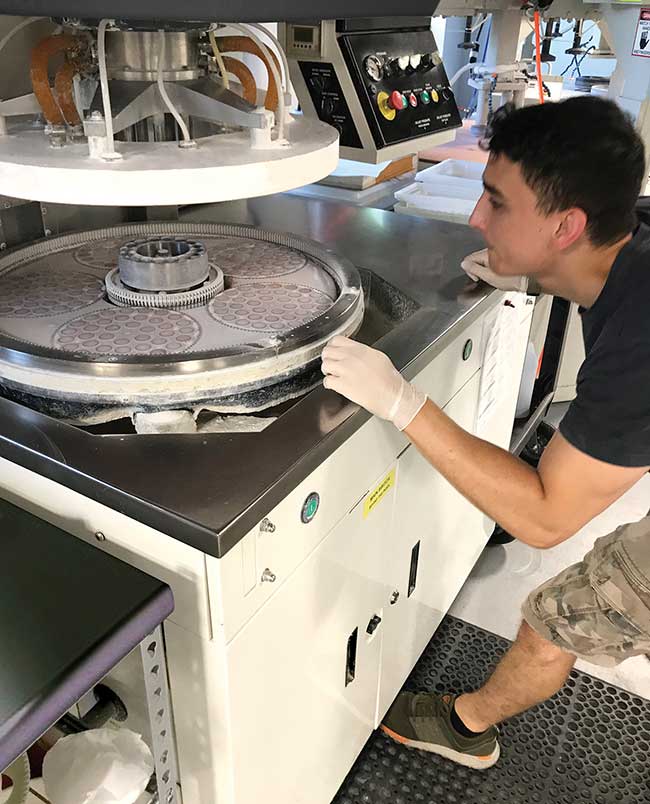STEPHEN ROWE, ESCO OPTICS INC.
The U.S. optics industry embodies innovation, reliability, and a commitment to quality — some of the best and most historically productive elements of American manufacturing. The result: a surprisingly unified industry, ready to navigate challenges on an international level and on a personal scale.
A community of competitors
Members of the team at New Jersey-based Esco Optics Inc. describe the U.S. optics industry as “tightly knit.” According to company CEO Lee Steneken, everyone knows everyone else and nobody moves from a role or a company to another without word getting around. “We have a unique industry where our customers are our competitors,” he said.

Esco Optics machinery measures an aircraft head-up display panel. Courtesy of Esco Optics.
The nature of the optics trade is that Monday’s competitor could be Tuesday’s client. It’s not uncommon for an optics firm to make a call to a competitor for help filling an order, whether that is because of timing, resources, or any number of other reasons. It’s because of these situations that competition in the U.S. optics industry is never black and white — and it’s why professional relationships are more nuanced than in other fields.
“In the grand scheme of things, there are not that many of us, so we do our best to work together,” Steneken said, referring to the practice as co-opetition. “If we know we’re going head to head against a competitor, we’ll reach out directly to them to see if we can come up with a way to split the business instead of undercutting one another.”
Challenges from overseas
Of course, not all competition is for the greater good. In recent years, U.S. optics companies have seen substantial portions of their business whisked to the other side of the world, where costs can be lower and margins significantly higher.

Esco Optics’ Bruce Van Orden, who has been with the company for 43 years, stands with a precision spindle polishing machine. Courtesy of Esco Optics.
Steneken believes China will continue to provide inexpensive optics, but not to the quality level of companies in the U.S. and Europe. Certain specialized markets, such as biomedical, will continue to rely on American-made optics; these clients simply require a much higher level of quality and precision than what they perceive is available from Chinese competitors.
“There also is a lot of good work being done in Europe — German and Swiss companies, in particular,” Steneken said. “But R&D projects for biomed, for cancer ablation, at the university level and so on, will be done here [in the U.S.] nine times out of 10.”
Since the U.S. Department of Defense is, for obvious reasons, prohibited from using nondomestic manufacturers for optics contracts, the country’s military should remain a steady business market for American firms.
The power of innovation
According to Bill Hill, business development specialist at Esco, the industry is trending toward freeform optics, lenses that differ from the conventional flat or symmetrically curved lenses, often having domelike styles known as aspherical. Customers including the U.S. Navy want lenses that can fit seamlessly into the shape of the wing of a plane without sticking out of the form factor. Freeform
lenses are far more challenging to measure and manufacture than traditional lenses. Hill posits that the future of American optics lies in highly complex products such as these, which demand extreme technical precision.

A depiction of an ultra-parallel-fused silica pressure window. Courtesy of Esco Optics.
“I doubt that China will have the technical sophistication to keep up,” he said. “They’ll beat us on price, but we will beat them in precision, quality, and complexity.”
Esco has invested heavily in up-to-date metrology equipment and capabilities, as today’s customers require higher levels of accuracy in tolerances and specifications than ever before. The trend in optics is toward smaller and more complex products and an increased need for ironclad, repeatable measuring of performance.
Challenges for the future
The most daunting threat to the nation’s optics industry may not be overseas competition, but rather the simple math of human factors. The industry surged in the 1970s and 1980s, with a wave of young, enthusiastic engineers and technicians at its forefront, but those experienced, highly skilled industry vets, though now at the top of their game, are looking toward retirement.

Logan Wickersham, of Esco Optics, prepares to unload a double-sided polishing machine. Courtesy of Esco Optics.
“My father’s generation made the optics industry boom,” Steneken said. “All of the owners are looking at succession plans, but not everyone has them. The challenge is finding qualified people. The transfer of skills and information happens over the course of years.”
He noted that new optics industry hires are gung-ho about doing work on computers, which is certainly desirable. But they’re not nearly as interested in actual fabrication and manufacture of the products.
There’s no doomsday scenario on the horizon yet. The University of Rochester and the University of Arizona have in-depth, dedicated programs in optics engineering, which have been producing appealing job candidates. And now, Optimax Systems in Rochester, N.Y., is spearheading the development of a national apprenticeship program across small and large optical manufacturers. Its goal is to attract new, young recruits fresh out of high school and from other industries.

A depiction of a round custom window and radar-sensing lens. Courtesy of Esco Optics.
Still, the state of the optics workforce is a serious concern for those looking to the future of the industry. “I need to generate a workforce that will be there in 15 years,” Steneken said. “I have about 10 years left with the current vets on my staff, and that’s true industrywide.”
‘Co-opetition’ at its best
In the meantime, the U.S. optics industry continues to stick together. Steneken learned this firsthand after a catastrophic fire in 2014 destroyed Esco’s New Jersey facility, along with its machinery, tools, records, and more. It could have been the end of Esco, but Steneken’s peers helped keep his company from going under.
“After the fire, it was my competitors who got us back on our feet,” Steneken said. “I had competitors loading machinery onto flatbed trucks, telling me, ‘When you’re ready, send it back.’ It’s the relationships that make this business so great.”
Meet the author
Stephen Rowe is director of marketing at Esco Optics, where he leads all marketing and brand outreach efforts. He has an extensive background in branding communications, trade shows, and digital design. Rowe is a graduate of the New England School of Art and Design at Suffolk University; email: [email protected].